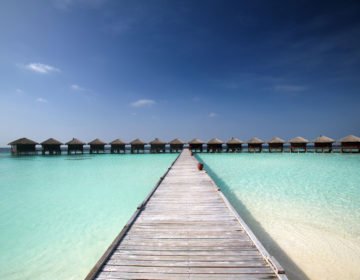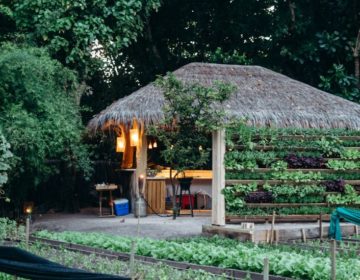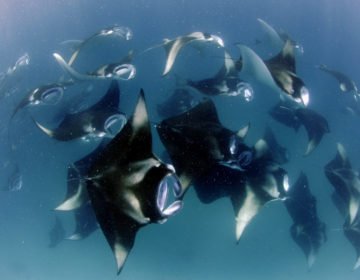South Nilandhe Atoll is 37 kilometers long and 12 kilometers wide. There are eight inhabited islands and 35 uninhabited islands of which two are resorts. Many of the uninhabited islands are small and in the northern part of the atoll. However, there are a number of small islands over a distance of 12 kilometers on the reef of Gemendhoo. There are many openings in the barrier reef although Kudahuvadhoo Falhu, being the longest reef in the atoll at 29 kilometers, restricts the accessibility from the southwest. Like North Nilandhe Atoll, the isolated resorts in this atoll have access to some heavily vegetated islands and other inhabited island of historical interest.

Kudavadhoo
Kudavadhoo is the capital of the island of the atoll and tradition says the original inhabitants of the Maldives, the so-called Redhin, lived on this island. Remnants of a large Buddhist temple are to be found here. The temple was destroyed when Islam came to the Maldives, but the elaborate gateway was left intact and serves as a poignant reminder of the previous religious era. Amidst the elegant decoration on the gateway is a symbol in the shape of a ‘Star of David.’ This is said to be an ancient symbol ‘Suleiman modi,’ the seal on King Solomon’s ring. A mosque was built on this old temple site using many of the handcrafted stones from the temple. The rear wall of the mosque is a fine example of crafted stone masonry. Set into the smooth wall is a stone block, about one square meter, with twelve sides and corners fitting beautifully into the surrounding stones.
There is also a very old graveyard with some fine tombstones, two of which are said to be that of the master mason who constructed the mosque. One of them lies at the foot of the grave, the other at the head. Both tombstones are very elaborate and, strangely, they have five points on the top but no one knows why. This is unusual, as Muslim tombstones are usually rounded on top for women and have one sharp point for men. There is a large man-made mound near the mosque, perhaps 25 meters in diameter, known as ‘Us Gandu’. No one knows why it was constructed as excavations made several years ago revealed nothing but a heap of sand. Near the mosque among the trees is a bathing tank, once used for the temple worshippers. Some archaeological relics have been found here, including a stone ‘head’, said to be so big a man could barely reach around it. It was reburied somewhere near the mosque. A stone image of an animal was found in the early 1940s and was sent Malé, never to be seen again.
 Kudavadhoo Island
Kudavadhoo Island
Eboodhoofushi and Oluveli
Eboodhoofushi and Oluveli are two resort islands now called Niyama Private Islands Maldives. They lie at the end of a long reef next to Kudahuvadhoo Kanduolhi. Coconuts were harvested from these islands.
Maaeboodhoo
Maaeboodhoo is another very old inhabited island and recent rebuilding of the mosque revealed the foundations of an early temple.
Issari
Issari is an uninhabited island with bushes and trees.
Hiriyafushi
Hiriyafushi is another uninhabited bushy island. Hiriya means the beautiful, the noble and the honorable presence of a revered guest.
Vaanee
Vaanee is a very old inhabited island that used to called Dhiguvaanee. There is a good anchorage in the lagoon and traditionally , dhonis sailing from Thaa Atoll would anchor overnight here before proceeding north to Faafu Atoll and then across to Malé. The islanders are renowned fishermen.
Kadimma
Kadimma is a resort and the first of many islands on this reef. Kadi means the entrance between a lagoon and the outside sea. Access to the inner lagoon can be found just inside the Vaanee Kandu.
 Kadimma Island
Kadimma Island
Bandudhoshu Kudarah
Bandudhoshu Kudarah is joined to Kadimaa. Bandu means stomach and possibly refers to the other island being close by.
Thilabolhufushi
Bolhu means bend and could refer to the location of the island on the reef, which begins to swerve around towards the north.
Naibukaloabodufushi
Naibukaloabodufushi means the Gazi, or magitrate’s island. Maybe in the past it was unhabited.
Thinhuraa, Kiraidhoo and Dhebaidhoo
Thinhuraa, Kiraidhoo and Dhebaidhoo are small, picturesque uninhabited islands.
Gemendhoo
Gemendhoo is a very small but beautiful island where the people have developed a fishing technique that takes full advantage of their unique geographic location. The island lies on a 10 kilometer long reef that has a scattering of 24 islands up the entire outside of the atoll, although some of them are a little more than sandbanks with a few bushes. Nearly all these islands are connected at low tide at which time they are surrounded by a wide and exposed reef. Inside the reef is a long, shallow lagoon that stretches the length of the islands.
On the inner atoll side, there are shallow openings across the reef at both the north and south ends of the lagoon. During the SW monsoon season, large schools of Mushimas, a tasty fish and a favorite with the people, swim through these channels to feed inside the lagoon during the day. At night, they return through the channels to get deeper water. During the afternoon, fishermen lay a long U-shaped net on the bottom of these two channels. On the ocean side, is a dhoni with the end of the net and along the channel are three men on each side carrying a long pole between each pair that hangs in the water below each net. When the fish swim through the channel to get to the outside, the first pair of men lift up their pole and trap the fish inside the channel. The fish are then herded through the channel to the next pair and so on until the end where they are eventually trapped and hauled into the waiting dhoni.
 Gemendhoo Island
Gemendhoo Island
Buhalafushi
Bulhalafushi is a small uninhabited island. Bulba means cat.
Hulhuvehi
Hulhu means big and vehi refers to a bushy island. It is uninhabited and mostly washed away.
Maalefaru
Maalefaru is a small uninhabited island and its name quite likely occurred because it is from here that many local island dhonis depart for Malé Atoll.
Kanneiyfaru
Kanneiyfaru is a small uninhabited island on the edge of the reef. Kanneiy means difficult to reach.
Badidhoo
Badidhoo is an old inhabited island. Badi means big gun, like the cannons once seen in Malé from the Portuguese and Dutch eras. Perhaps one of these guns was once located at this island.
 Badidhoo Island
Badidhoo Island
Aloofushi
Aloofushi is a small, uninhabited island named after the potato, aloo.
Lhohi
Lhohi is an uninhabited island and like many of the islands in Dhaalu, it is blessed with thick vegetation down to the water line and big trees. This is partly because all the inhabited islands in this atoll are large and with a relatively small population there has been no need to cut down the trees from other islands for boats and houses.
Udhdhoo
Udhdhoo is a very bushy uninhabited island.
Velavaru
Velavaru is a resort named Angsana. Vela are creeping bushes.
 Angsana Velavaru Resort
Angsana Velavaru Resort
Faandhoo
Faandhoo is another bushy island. Faan means very calm and refers to the waters around the island.
Meedhoo
Meedhoo is an uninhabited island with Mee gus, a species of tree that grows very large. There is a passion for story telling that invokes strong sense of history and rebelliousness among the islanders. One favorite story is told about a rebel countryman from this island, ‘Meedhu’ Thakur, who was an advisor to the Portuguese during the occupation of the Maldives in the 16th century.
In 1573, Muhammed Thakurufaanu led a small band of patriots to overthrow the Portuguese in Malé after a 15-year period of occupation and then went on a trip to the Southern Atolls to check the conditions there and to strengthen the rule of Islam. He heard Meedhu Thakur was building a ship on this island and furthermore, Meedhu would not allow any Maldivian to follow the religion of Islam. When news spread that Muhammed Thakurufaanu as heading for the island, Meedhu left secretly on a raft. Muhammed Thakurufaanu destroyed the ship he was building and then pursued him to Faafu Atoll.
After five days of searching, Meedhu Thakur was found in the jungle on the island of Dharaboodhoo. When Meedhu realized that capture was imminent, he committed suicide by thrusting himself with a long-bladed knife.
 Meedhoo Island
Meedhoo Island
Meedhufushi
Meedhufushi is a small island on the north side of Velvaru Kandu ‘belonging’ to Meedhoo. It is now a resort called Sun Aqua Vilu Reef.
Maagau
Maagau means big stone island. It is now a resort named Baglioni.
Ribudhoo
Ribudhoo has a reputation for employing very artistic people. Ribu means Goldsmith and the island is still renowned for its gold craftsmen. The inhabitants were formerly the chief jewellers in the Maldives. It used to be a custom that every year the islanders had to pay a small fine of coir rope to be given to the military in Malé. It is believed this custom was introduced centuries ago because the people once rebelled against the sultan. This custom continued until 1940.
 Ribudhoo Island
Ribudhoo Island
Dhoores
Dhoores is a resort named Aaavee’s Nature Paradise. Dhoo means tongue.
Vommuli
Vommuli is a resort named St. Regis Vommuli Resort. Vom originally meant ‘round’, but Voh also means candleholder, like those found in Buddhist temples and still found in old mosques. Muli is a protruding portion of reef.
 St. Regis Vommu Maldives
St. Regis Vommu Maldives
Hudhufushi Finolhu
Hudhufushi Finolhu is a long, narrow uninhabited island.
Maadheli
Maadheli is an uninhabited island that is sometimes referred to as ‘Temple Island’. It was formerly inhabited and contains the ruins of Buddhist temples. This is one island the legendary Redhin were believed to have inhabited. Maa is big and dheli means charcoal and is also the ink used in pens. The island has a good anchorage in the lagoon during the SW monsoon.
Hulhudheli
Hulhedheli is an old inhabited island with the remains of a temple washed away on the reef on the west side of the island. One of the first mosques in the Maldives was built here and part of the original building can be seen under the more recent one.
(Source: Dive Maldives: A guide to the Maldives Archipelago. Tim Godfrey. Atoll Editions)



